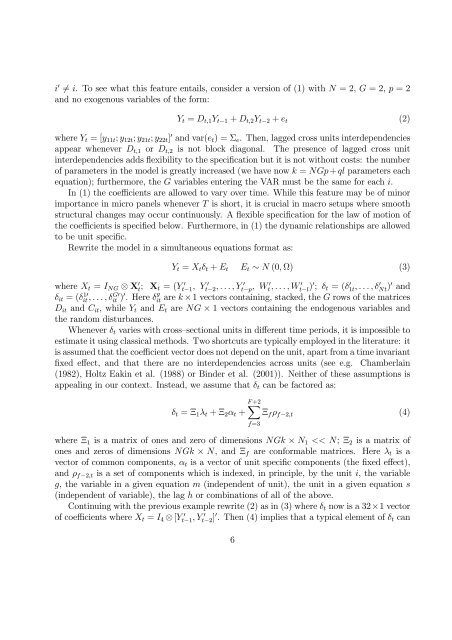PANEL INDEX VAR MODELS: SPECIFICATION, ESTIMATION - Ivie
You also want an ePaper? Increase the reach of your titles
YUMPU automatically turns print PDFs into web optimized ePapers that Google loves.
i = i. To see what this feature entails, consider a version of (1) with N =2,G =2,p =2<br />
and no exogenous variables of the form:<br />
Y t = D t,1 Y t−1 + D t,2 Y t−2 + e t (2)<br />
where Y t =[y 11t ; y 12t ; y 21t ; y 22t ] and var(e t )=Σ e . Then, lagged cross units interdependencies<br />
appear whenever D t,1 or D t,2 is not block diagonal. The presence of lagged cross unit<br />
interdependencies adds flexibility to the specification but it is not without costs: the number<br />
of parameters in the model is greatly increased (we have now k = NGp+ ql parameters each<br />
equation); furthermore, the G variables entering the <strong>VAR</strong> must be the same for each i.<br />
In (1) the coefficients are allowed to vary over time. While this feature may be of minor<br />
importance in micro panels whenever T is short, it is crucial in macro setups where smooth<br />
structural changes may occur continuously. A flexible specification for the law of motion of<br />
the coefficients is specified below. Furthermore, in (1) the dynamic relationships are allowed<br />
to be unit specific.<br />
Rewrite the model in a simultaneous equations format as:<br />
Y t = X t δ t + E t E t ∼ N (0, Ω) (3)<br />
where X t = I NG ⊗ X t; X t =(Yt−1, Yt−2,...,Y <br />
t−p, Wt,...,W <br />
t−l ) ; δ t =(δ1t,...,δ Nt) and<br />
δ it =(δit,...,δ 1<br />
it G ) .Hereδ g it are k × 1 vectors containing, stacked, the G rows of the matrices<br />
D it and C it , while Y t and E t are NG × 1 vectors containing the endogenous variables and<br />
the random disturbances.<br />
Whenever δ t varies with cross—sectional units in different time periods, it is impossible to<br />
estimate it using classical methods. Two shortcuts are typically employed in the literature: it<br />
is assumed that the coefficient vector does not depend on the unit, apart from a time invariant<br />
fixed effect, and that there are no interdependencies across units (see e.g. Chamberlain<br />
(1982), Holtz Eakin et al. (1988) or Binder et al. (2001)). Neither of these assumptions is<br />
appealing in our context. Instead, we assume that δ t can be factored as:<br />
F<br />
+2<br />
δ t = Ξ 1 λ t + Ξ 2 α t + Ξ f ρ f−2,t (4)<br />
where Ξ 1 is a matrix of ones and zero of dimensions NGk × N 1

















